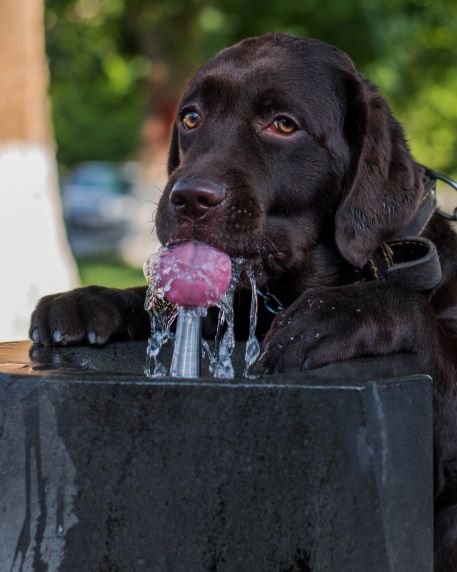By Deanna deBara
This article was originally published by The Dog People: Powered by Rover
You want to make sure your dog has everything he needs to stay happy and healthy. And a big part of that? Hydration.
Just like humans, dogs need water to survive. And if they don’t get the water they need, they can quickly become dehydrated—and dehydration can put your dog at serious risk.
But what, exactly, is dog dehydration? What are some of the signs you should be on the lookout for? And how can you make sure your pet has all the water he needs to feel his happiest, healthiest, and most hydrated self?
What is dog dehydration?
So, first things first—before we jump into the symptoms of dog dehydration, let’s quickly cover what, exactly, dog dehydration is.
A dog gets dehydrated when he’s losing more water (through normal processes like panting and urination) than he’s taking in. In order to compensate, a dog’s body starts pulling water from his cells—which causes a loss of key electrolytes, like chloride, sodium, and potassium. This loss of electrolytes can lead to a host of health risks (including more serious risks like organ failure or—in extreme cases—death).
Signs of dog dehydration
Ok, so now that you know what dog dehydration is, let’s talk about how to spot it.
There are a number of causes for dog dehydration, from not ingesting enough water throughout the day to vomiting to overheating from scorching summer temperatures—but no matter the cause, the symptoms are the same. Some common signs of dog dehydration include:
- Excessive panting
- Dry nose
- Dry gums
- Low energy and/or lethargic behavior
- Dry eyes
- Decreased or non-existent appetite
- Slowed response time
- Dry, sunken eyes
- Decreased need for urination
- Dark appearance to urine
- General weakness, especially when attempting to walk
- Loss of skin elasticity
Is my dog dehydrated?
If you notice your dog exhibiting any symptoms of dehydration, give him some water to rehydrate to be on the safe side.
But some of the symptoms of dog dehydration are pretty vague; for example, your dog could have low energy because he just got back from a long walk—not because he’s actually dehydrated. And others (for example, skin elasticity) are impossible to determine by just looking at your dog. So the question is—how can you check to see if your dog is dehydrated?
If you suspect your pet might be struggling with dog dehydration, here are a few tests you can implement to see if dehydration is the real issue:
Check your dog’s skin elasticity
One of the fastest ways to check for dog dehydration? A quick pinch of the skin.
Pinch a small portion of your dog’s skin between your thumb and pointer finger. Hold it there for a second or two and then release.
If your dog is properly hydrated, the skin will immediately bounce back into place. If your dog’s body lacks water, things won’t be quite so elastic—and it will take some extra time for your dog’s skin to return to its original position.
Ideally, you should test your dog’s skin elasticity when you know he’s properly hydrated; that way, you know what normal, well-hydrated skin elasticity is for your dog—and have a baseline to compare things to if you suspect your dog is dehydrated.
Check your dog’s gums
Another quick way to check your dog’s hydration levels is with a gum test. A healthy, hydrated dog will have moist, slick gums—while the gums of a dehydrated dog will feel dry and tacky. If your dog feels like he has a serious case of dry mouth, chances are, he’s dehydrated.
You can also test your dog’s capillary refill time by pressing gently on his gums. When you press on your dog’s gums, they’ll turn white. If your dog is properly hydrated, the gums will almost immediately return to their pink color when you remove your finger (and take the pressure off their gums). If your dog is dehydrated, the capillaries will take longer to refill—and your dog’s gums will stay white for a much longer period of time.
How to prevent dog dehydration in your pet
If your dog is dehydrated, it’s important that you rehydrate them as soon as possible. Depending on the level of dehydration, this might be as simple as getting them in front of a nice, big bowl of water—or, in more severe cases, might require a trip to the vet.
Dog dehydration needs immediate treatment. But how can you prevent it from happening in the first place?
Here are a few ways to make sure your dog stays properly hydrated:
- Make sure your dog has access to water. It sounds obvious, but if you want to make sure your dog stays hydrated, you need to make sure he has easy access to water throughout the day. Make sure to put his water bowl in an area he can easily get to, check it throughout the day, and refill as necessary.
- Track your dog’s water intake. One of the best preventative steps you can take to avoid dehydration is to get familiar with how much water your dog actually drinks. Some dogs need more water than others—and when you know how much water your dog drinks when he’s properly hydrated, it’s easier to notice when he’s not drinking enough.
- Try ice cubes. If your dog isn’t drinking water, try ice cubes! Letting your dog lick ice cubes can be a great way to “trick” him into replenishing his fluids when water, for whatever reason, just doesn’t sound appetizing (this is a great trick for dogs with nausea and/or vomiting!).

